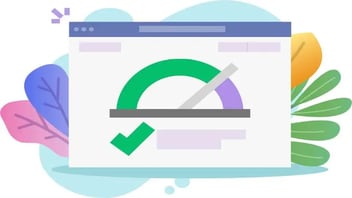7 tendencias de diseño web para crecer
Animación. Imágenes de héroes. Olvídese de las palabras de moda y las modas llamativas: es importante centrarse en lo que viene a continuación en el contexto de la estrategia de marketing en línea y los objetivos SMART de su organización.
Si está listo para renovar el diseño de su web, céntrese en las tendencias que aumentarán la velocidad y las tasas de conversión,

La velocidad es el rey
Durante años, el contenido mantuvo la corona en el mundo del marketing y SEO. El contenido atractivo y SEO-friendly sigue siendo fundamental para el éxito de su sitio web. Pero en julio de 2018, Google lanzó su actualización de velocidad para todos los usuarios, incluidas las búsquedas móviles. Ahora la velocidad de su sitio web será un factor en su clasificación de página. Este es un fuerte incentivo para repensar los elementos de diseño que pueden retrasar el tiempo de carga de una página, como fotos enormes, videos largos o Javascript engorroso. Desde 2019, se ve a los diseñadores web adoptar un enfoque consciente de la velocidad.
1. Hacer uso del diseño plano
Este enfoque minimalista favorece las líneas limpias, mucho espacio en blanco y diseños despejados. Las páginas que utilizan el diseño plano suelen cargarse rápidamente porque carecen de elementos visuales como fotos y vídeos de gran tamaño. Sin embargo, estos diseños son atractivos gracias a bloques de colores vivos y tipografías llamativas. Los iconos y el arte lineal seguirán desempeñando un papel esencial en el diseño plano porque proporcionan elementos visuales sencillos y limpios que pueden adaptarse fácilmente al color, tamaño y sensación que necesites sin ralentizar el tiempo de carga.
2 . Considerar las páginas móviles aceleradas (AMP)
AMP no es nada nuevo. Introducido como una iniciativa de código abierto por Google y Twitter en 2015, AMP es una especie de HTML lite diseñado para ofrecer la máxima velocidad y legibilidad para los usuarios móviles. Aunque AMP solía ser más o menos opcional, abordar la velocidad móvil en nuestro mundo post-Speed Update es esencial. Aunque parezca una cuestión de desarrollo, los diseñadores web deben saber que AMP requiere un CSS mucho más simple y muy poco Javascript, lo que puede afectar a las opciones de diseño.
3. Ofrecer contenido web desnatable
Los estudios demuestran que los usuarios dedican cada vez menos tiempo a evaluar un sitio web, por lo que la primera impresión del visitante es más importante que nunca. En los próximos años, seguirá viendo diseños con titulares rápidos y destacados y otros elementos de texto, como subtítulos y textos breves de apoyo, que ayuden a los visitantes a evaluar rápidamente el contenido de un sitio. Esto no significa que vayan a desaparecer las páginas más largas; véase más abajo otra tendencia aparentemente contradictoria: las páginas de aterrizaje más largas.
Recuerde que no se trata de la velocidad por la velocidad o sólo por el bien de Google. Cuando su sitio web se carga rápidamente, es más probable que la gente se quede para ver lo que tiene que decir, por lo que un sitio web más rápido puede ayudarle a obtener más conversiones sólo por llevar a la gente al sitio en primer lugar.
La conversión va más allá de los botones
Todos nos hemos acostumbrado a ver y utilizar botones de llamada a la acción (CTA) en Internet. Estos botones han evolucionado en los últimos años con jerarquías de CTA que incluyen diferentes estilos de botón para los botones CTA secundarios y terciarios y, más recientemente, con la adopción generalizada de botones translúcidos que distraen menos. Los botones CTA son herramientas de conversión increíblemente eficaces, y la optimización de los CTA es fundamental para mejorar sus conversiones.
Pero los diseñadores web deben tener en cuenta otras técnicas de conversión.
4. Implementar chatbots
Impulsados por el mismo tipo de inteligencia artificial (IA) que impulsa las sugerencias de etiquetado de fotos de Facebook y los autocompletados de Google Search, estos bots son cada vez más sofisticados. Son un medio estupendo para recabar información sobre un posible cliente antes de que el equipo de ventas inicie el contacto. En los próximos años, los diseñadores web irán más allá de la ventana emergente convencional del chatbot para encontrar formas novedosas y bien pensadas de integrar visualmente los chatbots en el diseño general de un sitio.
5. Utilizar un diseño que responda a los objetivos
Es probable que esté familiarizado con el diseño responsivo que muestra un sitio web para su dispositivo específico. El siguiente paso (gigantesco) es adaptar el sitio web en función de los objetivos de cada visitante en cada visita. Imagina que visitas una tienda de ropa online y respondes a preguntas sobre tu talla y lo que buscas. Entonces todo el sitio web podría cambiar en función de sus respuestas. Mostrar a los visitantes exactamente lo que buscan es una técnica probada para aumentar las conversiones y será cada vez más accesible gracias a la IA y el aprendizaje automático.
6. Implementapáginas de destino más largas
Es cierto que menos sexy que las dos tendencias anteriores, las páginas de destino más largas están llegando a los sitios web B2C y B2B. Las páginas de destino más largas les permiten contar una historia completa, llevándoles más lejos en el ciclo de compra. Es una oportunidad para abordar las necesidades de sus diferentes buyer personas o para responder a las preguntas más frecuentes. Si se diseñan (y redactan) con eficacia, las páginas de destino más largas ayudan a conseguir más conversiones para una campaña específica.
7. Considere el diseño de una sola página
En el otro extremo del espectro, los sitios web de una sola página siguen ganando popularidad. Aunque eliminan la oportunidad de proporcionar información en profundidad en torno a varias palabras clave específicas, los sitios web de una sola página son fáciles de mantener. Pueden ayudar a mejorar su autoridad de dominio porque todos los enlaces entrantes apuntarán a la misma URL. Estos sitios sencillos son ideales para organizaciones que hacen hincapié en una única CTA central, como la programación de consultas.
Las expectativas de los usuarios de su sitio web seguirán aumentando, y el diseño web debe evolucionar para ofrecer una experiencia más receptiva y personalizada.
Para obtener más información sobre cómo transformar el diseño de su sitio web en un recurso inestimable para su marketing de crecimiento, póngase en contacto con nosotros para programar una consulta.
Este contenido también está disponible traducido en:
- Alemán: 7 Website-Design-Trends für Wachstum
- Inglés: 7 Website Design Trends for Growth
- Francés: 7 tendances en matière de conception de sites web pour la croissance
- Italiano: 7 tendenze di design del sito web per la crescita
- Rumano: 7 tendințe în materie de website design pentru creștere
- Chino: 7 个促进增长的网站设计趋势









Deja un comentario